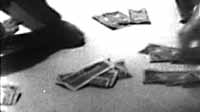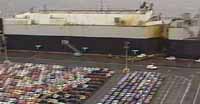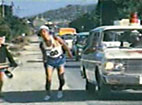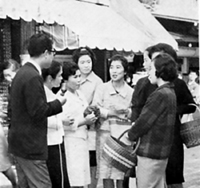|
The television vernacular
In November 1957, Japan
Unveiled, Japan's first TV documentary series, made its debut.
Yoshida Naoya, a young director inspired
by social issues, used audio recording techniques borrowed from radio
and adopted a novel approach to the making of documentaries called "hypothesis
verification." The first installment employing this approach was
New Religions. In the eighth, Jirocho
and the Japanese, which presented the reality of the Japanese
yakuza underworld, Yoshida highlighted the survival of traditional customs
in Japanese society. His pioneering documentaries were a hit with the
public.
Quest for documentary TV
In 1964, Japan
Unveiled was succeeded by Images of
Contemporary Society. In features like
Chisso Corporation's Shareholders' Meeting and The
Dazzling Blue Sky, the program went beyond the context of social
problems and dug deep to expose the inside story. In doing so, it expanded
the possibilities of the TV documentary.
Documentary,
which started in 1971, offered programs that were linked to current
news stories. Using a variety of film techniques, it took a penetrating
look at contemporary society.
Features like Sleepless
Villagers and The Women of Fusei
adopted a direct approach, presenting viewers with the raw experience
of the programs' themes. This technique struck a chord with audiences.
Seeds of mighty projects
"Why not bring together all the capabilities
we've developed to create a heavy-duty current affairs show for the
Sunday evening golden hour?" This idea led to the debut in 1966
of Current Affairs Special, which
was aired each Sunday from 9:30 to 10:10 p.m. The format and subject
matter were placed under virtually no restrictions. The name changed
to Sunday Special in 1970, but the
objective of serious, hard-hitting TV journalism remained the same.
|
|
Sunday Special
employed a wide assortment of presentation techniques including studio
debates, multiple live feeds, reports and documentary footage, and it
took on such issues as pollution, prices, and agricultural problems.
As such, it established a solid foundation for major current affairs
programs in the evening, and can be considered the forerunner of NHK
Tokushu.
A mirror of the moment
The incisive insights of presenters help
viewers make sense of their rapidly changing and increasingly complex
society.
Saturday Report,
launched in 1982, pioneered a new style for current affairs programs
with its rhythmic alternation of recorded pictures and studio commentary,
and innovative use of video. The appeal of programs like The
Ins and Outs of Automobile Freighters and Indian
Merchants in Osaka was their freedom to look at a contemporary
issue from any angle as long as it exposed an important facet of the
modern world.
This production concept was carried over
to the daily program Today's Close-up,
which was launched in 1993 with an edition titled "The Russian
Crisis."
The commitment to a new theme every day
and a knack for picking timely stories enabled the program to respond
to viewers' thirst for a deeper understanding of the world around them.
The aim of Today's Close-up was to
be "a mirror of the moment."
In addition to revealing, viewer-friendly,
and informative reporting about what lay behind the news, the program
added the expertise of numerous guests who were capably interviewed
by Kuniya Hiroko. Today's Close-up
earned praise for being an observatory of society, and for its unmatched
originality.
After 10 years as a current affairs program
for prime time, Today's Close-up has
now broadcast over 1,700 features.
|








